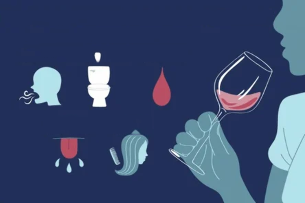
Many people do not drink alcohol during the work week, but allow themselves to rest on the weekends by drinking a few beers or stronger drinks a day. It should be noted that this approach is dangerous and can cause health problems. This is due to the fact that it is difficult for the body to process large doses of alcohol that have been received in 2 days.
To avoid serious problems, you need to know the daily dose of alcohol that is considered safe.
How much alcohol should not be drunk
I'll let you know soon - there is no consensus on this issue. Some scientists say that even in small amounts, alcohol has a detrimental effect on the body. Others believe that in small doses, alcohol is also beneficial. And there is a WHO (World Health Organization) recommendation, which, according to him,dangerous alcohol doseis 60 ml of ethanol for menand50 ml for women. But since very few people use ethanol in its pure form (well, I hope), such is the very dangerous form of alcohol in terms of the drink most people usually drink:
- 180 g vodka for men and 150 g vodkafor women
- 1. 5 l. bir
- 0. 5 l. wain
A truly dangerous dose of alcohol- the average value of the amount of alcohol consumed, enough to cause death.
But do not think that if you drink less than these values, then nothing will happen to the body. Even if you take the equivalent of 30 ml of ethanol a day (90 g of vodka, 800 ml of beer, or a large glass of wine), you can seriously endanger your health.

Formulas for determining individual alcohol levels
Health professionals have developed a formula that can be used to calculate a person's alcohol intake. By using this method, you can freely determine how much alcohol you can drink each day without endangering your health.
1. 5 g of ethyl alcohol per 1 kg of human weight is taken as a base. If a person weighs 70 kg, the individual ethanol dose is 105 ml. However, it should be understood that these values are average, as much depends on the age, gender and physiological characteristics of the organism.
What happens if you drink alcohol every day?
Scientists have long studied this issue. Recent evidence suggests thatalcohol reduces the risk of atherosclerosis. In part, it helps prevent the blockage of blood vessels by cholesterol plaques. Why is cholesterol dangerous? It causes circulatory problems. The blood stops circulating normally through the blood vessels, as it is filled with cholesterol, and the person may even die. Alcohol, on the other hand, "squeezes" the blood vessels and does not let cholesterol get stuck.
Does this mean you can drink alcohol every day? No. In this case, we are talking about a very low dose of alcohol. Based onthe same WHO recommendations, experts advise at least two days a week to completelystay away from alcohol. Of course, the longer you do not drink, the better.
Optimal dosealcohol, which is not too harmful to health, and can even bring certain benefits,is considered 150 mldried red wine.
But this does not mean that you have todrink every daya small glass of wine, although there are many stories circulating on the Web, how some grandparents drank a glass every day and are 90 years old. Everything here is individual and needs to take into account many factors - from chronic illness to hereditary predisposition. Not to mention the fact thatalcohol is categorized as contraindicatedfor minors and pregnant women.
Did you know that alcohol stays in your hair for the longest time?
If you drink alcohol every day, the body will not be able to remove it from the body, and diseases such as alcoholism will begin. It has 3 stages, and in this article we will discuss it. But first, let’s understand - how does alcohol generally affect a person?
Incredible intoxicating drinks have been popular for centuries, although they are pronounced differently in each country: digestion, ale, braga, etc. In ancient times, it was believed that amber drink increased appetite, strengthened health, helped to grow and develop, so it was considered norma to give it to children. Beer can please both of you on a hot day and on a cold night. For example, in the mid-20th century in Italy, they were encouraged to have fun all year round, not just in the summer. At that time, beer was associated with urban lifestyle, fashion trends and even progress. And now there are many flavors of this frothy drink, sure to be enjoyed during breakfast, lunch and dinner.
The famous joke "There are 24 hours a day, 24 bottles in a beer box - by chance? " this confirms. But jokes, jokes, and from foam you can get good problems for your health, if you do not know the steps. In this article we will find out what are the benefits and dangers of this drink, in what amount it can be drunk and whether there are contraindications.
How alcohol works

The brain of ordinary people and drunkards. In the latter case, most of the connections in the brain are destroyed
What is alcohol in a scientific sense? This isethyl alcohol, which is made by fermentation of sugar, yeast and starch. And all these "nuclear" mixtures have extraordinary properties: they go through all levels of digestion very quickly. That is, when you digest lunch soup (about 30 minutes) or chicken (up to 2 hours), alcohol quickly achieves its purpose - the human circulatory system, sometimes even passes through the liver, if you drink in a serious scale. He could not produce large amounts of alcohol.
Alcohol begins to do bad business in the circulatory system: it damages red blood cells (small bodies that make up blood), which is why they stick together, forming blood clots. Blood clots, in turn, block blood flow in small arteries, and this causes blockage of blood vessels in the brain. Thus, a feeling of intoxication arises, which is similar to when the brain lacks oxygen.
Red blood cells of a person who has consumed a lot of alcohol. They are almost all united
Therefore, if you do not drink alcohol in moderation, the brain will always be in this state. This will cause many mental and physical functions to deteriorate - a condition comparable to drinking a lot of alcohol at one time. One cannot stand normally and give no explanation for one's actions.
Scientists have shown that alcohol damages DNA and increases the risk of cancer.
Beer in the modern world
Any store now offers a wide selection of liquors. To make the right choice, you need to understand what type of foam is, and how they differ from each other. Beer can be divided into 2 types: medium and strong.
Ordinary beer contains a small amount of alcohol, about 4 percent. It is further divided into 2 types: light and dark. The strength of the draft drink can reach 8 percent.

Alcohol can contain up to 12 percent alcohol. It differs from the simple in that it has a slightly bitter taste, odor, and taste.
This drink is considered whole. Keep in mind that about 90% of the range given to customers refers specifically to the whole. The average alcohol content in this form is about 7 percent.
Alcoholism level
Continuous use of alcoholleads to alcoholism, which has three levels.
- Withthe first stagealcohol dependence, a person gradually loses control over the amount of drink consumed, leading to the emergence of pathological cravings for alcohol.
- Atsecond stagea person even develops an "immunity" to alcohol, or rather, it seems so. Indeed, if a person at this stage consumes more than 1 liter of alcohol, the body will seem to begin to feel alcohol more easily. In fact, it hides the development of serious diseases - hepatitis, liver cirrhosis, esophageal cancer and stomach cancer.
- Alcoholismthird levelis characterized by a complete decline in personality in the physical and mental spheres. One can no longer drink alcohol and in most cases die.
Scientists believe that alcoholism is influenced by hereditary tendencies caused by insufficient production of enzymes that metabolize alcohol. But in fact, the amount of alcohol consumed affects this. You do not need to drink if you realize that you are losing control of yourself and that unpleasant body conditions appear.

Alcoholism is a disease and must be treated
Drinks benefits
Surprisingly, beer also has valuable health benefits, but most are not related to its intake. It is used externally:
- Beer foam is used to smooth wrinkles for masks that improve facial skin condition.
- Beer is an essential ingredient in hair masks, making it strong, thick and soft.
- If a person gets sick with an acute respiratory infection and drinks a little warm beer, recovery and health improvement will be faster.
- A reasonable dose of beer will help remove harmful heavy metals from the body, so drink the drink at an acceptable rate and your kidneys will be healthy.
- If you occasionally drink beer, because of the silicon content in it, the skeletal system will be stronger.
Take care of your health!
WARNING! The information published in the article is for informational purposes only and is not an instruction for use. Make sure you see a doctor!
Why does drunkenness occur?
This question is often asked the next morning after a busy party (usually with the words "well, I will definitely not drink again"). In fact, the explanation is quite simple: alcohol enters the body's bloodstream quickly, but leaves it VERY slowly. And the human body can not fully recover after a stormy night so the substance is destroyed and digested completely. This is howintoxication occurs.
Last year in our country they tried to make beer without getting drunk on vitamins. I wonder if they succeeded?
Of course many ask,how to avoid getting drunk, before starting to celebrate the next event with alcohol. But the answer can be summed up in one sentence: do not drink in large quantities, and then alcohol will have time to leave the body before your head touches the pillow.
How do I drink alcohol?
Researchers distinguish between the "northern" drinking model and the "southern" drinking model. The first includes Belarus, Kazakhstan, the Baltic countries, which drink a lot of alcohol, and in surprising doses, and not always frequently. The "southern" model is typical of Spain, Italy, Greece, where they can drink more often, but less alcohol and stronger: for example, a glass of dry wine at dinner. No one drinks 100 g of vodka every day.
Scientists agree that the southern model is safer for health, although they still note that daily alcohol intake is harmful to health. So do not use too much.
Historical data
Beer is one of the oldest drinks. If you believe in history, then for the first time it was compiled about 8000 years ago. It should be noted that at that time women were involved in the manufacture of such beverages. It is produced mainly at home. Only after beer began to gain popularity and began to be sold did men become interested in the production business.
Of course, in our day, brewing is considered a purely masculine occupation, although, as is known from history, it all started in a completely different way. Most of the drinks were produced in the Middle Ages, and are known for their incredible taste in England, the Czech Republic and Germany. For this reason these countries do not lose their titles and continue to make delicious intoxicating drinks.
This case is popular in many countries. People who can make beer are highly regarded. A variety of ingredients are selected for production, so the taste of beer is also different.
























